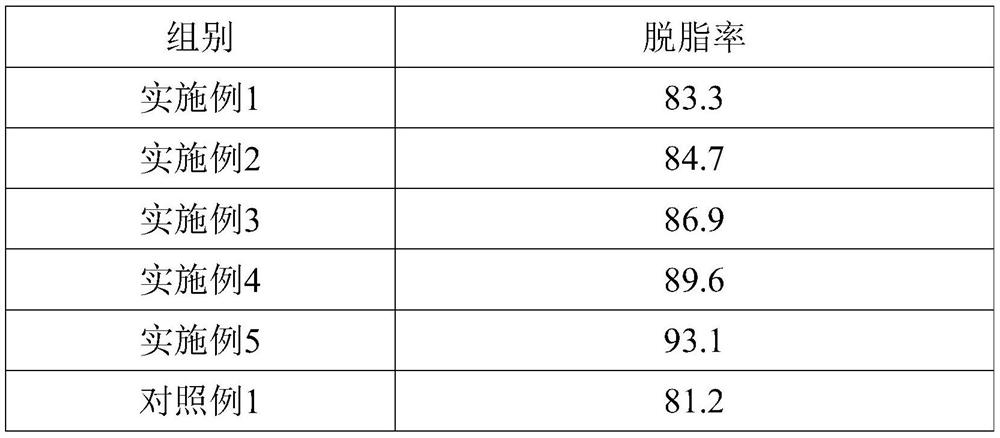A highly efficient degreasing agent for natural leather
A technology of natural leather and degreasing agent, applied in leather degreasing, small raw hide/large raw hide/leather/fur treatment, small raw hide/large raw hide/leather hide/fur chemical treatment, etc. Cleaning, complex sewage composition and other problems, to achieve the effect of mild chemical properties, reduce cleaning water consumption, and reduce pollution
- Summary
- Abstract
- Description
- Claims
- Application Information
AI Technical Summary
Problems solved by technology
Method used
Image
Examples
Embodiment 1
[0023] (1) Mix 10g of water treatment grade polyglutamic acid and 3g of poloxamer 188, add water to dissolve, and add dropwise dilute sulfuric acid to adjust the pH value of the solution to 4-5, then heat to reflux state and keep stirring, after the reaction Concentrate under reduced pressure to make a paste with a solid content of 75-85%. After the paste is naturally cooled to room temperature, it is sent to a freeze dryer. Poloxamer esters;
[0024] (2) Add the prepared polyglutamic acid-poloxamer ester compound, 10g PEG-60 hydrogenated castor oil, 5g sodium lauroyl glutamate, 2g polyethylene oxide, 3g chitosan to 20g decyl glucoside Sugar quaternary ammonium salt, 1g of hydrolyzed polymaleic anhydride and 0.5g of ethylenediaminetetraacetic acid disodium salt are thoroughly mixed and then ball milled in a ball mill until the output particle size is less than 30 μm to obtain a degreasing agent.
Embodiment 2
[0026] (1) Mix 10g of water treatment grade polyglutamic acid and 5g of poloxamer 188, add water to dissolve, and add dropwise dilute sulfuric acid to adjust the pH value of the solution to 4-5, then heat to reflux state and keep stirring, after the reaction Concentrate under reduced pressure to make a paste with a solid content of 75-85%. After the paste is naturally cooled to room temperature, it is sent to a freeze dryer. Poloxamer esters;
[0027] (2) Add the prepared polyglutamic acid-poloxamer ester compound, 15g PEG-60 hydrogenated castor oil, 8g sodium lauroyl glutamate, 3g polyethylene oxide, 2g chitosan to 15g decyl glucoside Sugar quaternary ammonium salt, 1g of hydrolyzed polymaleic anhydride and 0.5g of ethylenediaminetetraacetic acid disodium salt are thoroughly mixed and then ball milled in a ball mill until the output particle size is less than 30 μm to obtain a degreasing agent.
Embodiment 3
[0029] (1) Mix 10g of water treatment grade polyglutamic acid and 5g of poloxamer 188, add water to dissolve, and add dropwise dilute sulfuric acid to adjust the pH value of the solution to 4-5, then heat to reflux state and keep stirring, after the reaction Concentrate under reduced pressure to make a paste with a solid content of 75-85%. After the paste is naturally cooled to room temperature, it is sent to a freeze dryer. Poloxamer esters;
[0030] (2) Add the prepared polyglutamic acid-poloxamer ester compound, 15g PEG-60 hydrogenated castor oil, 8g sodium lauroyl glutamate, 3g polyethylene oxide, 2g chitosan to 15g decyl glucoside Sugar quaternary ammonium salt, 1g of hydrolyzed polymaleic anhydride and 0.5g of ethylenediaminetetraacetic acid disodium salt are thoroughly mixed and then ball milled in a ball mill until the output particle size is less than 30 μm to obtain a degreasing agent.
[0031] Modification of polyethylene oxide: first add 50g of hot water at 60-70°...
PUM
 Login to View More
Login to View More Abstract
Description
Claims
Application Information
 Login to View More
Login to View More - R&D
- Intellectual Property
- Life Sciences
- Materials
- Tech Scout
- Unparalleled Data Quality
- Higher Quality Content
- 60% Fewer Hallucinations
Browse by: Latest US Patents, China's latest patents, Technical Efficacy Thesaurus, Application Domain, Technology Topic, Popular Technical Reports.
© 2025 PatSnap. All rights reserved.Legal|Privacy policy|Modern Slavery Act Transparency Statement|Sitemap|About US| Contact US: help@patsnap.com


